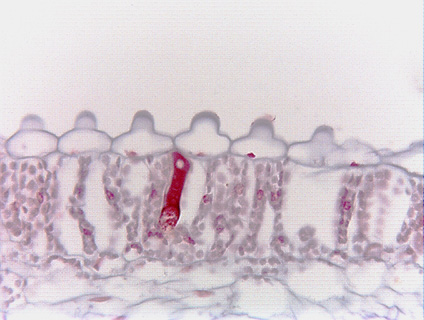Up
Ordinary epidermis
Guard cells
Thick cuticle
Thicker cuticle
Thin cuticle
Parasitic plant
Petal epidermis
Sclerified epidermis
Papillose epidermis
Sculptured cuticle
Elaborate cuticle
Cuticular horns
Radial walls
Cuticle proper
No epidermis
Epidermal peels
Cycad peel
Paradermal
Typical stoma
Sunken stoma
Stomatal orientation 1
Unusual orientation 2
Artifact
Stomata and fibers
Stomatal crypts
Crypts, mag.
Crypt margin
Non-crypt
Water lily
Stomatal channels
Groove, hi mag
Subsidiary cells
Ledges
Papillae
Trichome
Uniseriate hair
Peltate hair, mag
Peltate, lo mag
Branched hairs
Trichome base
Lithocyst, Ficus
Lithocysts, hemp
Bulliform cells
Grass epidermis
Multiple epi
Uniseriate?
Peperomia
| |
 Fig.
10.2-9.
Transverse section of elephant’s ear leaf (Colocasia; a relative of Philodendron).
These are papillose
epidermis cells. The outer wall was softened and then turgor pressure
pushed the wall outward into the shape of a papilla. This can occur to various
degrees in different species, such that the outer wall merely bulges slightly,
or to the extreme of bulging out so much that it is considered to be a trichome
rather than a papilla (there is no fundamental difference between a unicellular
trichome and a papillose epidermis cell). Four dark red nuclei are visible, all
located against the inner wall. Fig.
10.2-9.
Transverse section of elephant’s ear leaf (Colocasia; a relative of Philodendron).
These are papillose
epidermis cells. The outer wall was softened and then turgor pressure
pushed the wall outward into the shape of a papilla. This can occur to various
degrees in different species, such that the outer wall merely bulges slightly,
or to the extreme of bulging out so much that it is considered to be a trichome
rather than a papilla (there is no fundamental difference between a unicellular
trichome and a papillose epidermis cell). Four dark red nuclei are visible, all
located against the inner wall.
|
 Fig.
10.2-9.
Transverse section of elephant’s ear leaf (Colocasia; a relative of Philodendron).
These are papillose
epidermis cells. The outer wall was softened and then turgor pressure
pushed the wall outward into the shape of a papilla. This can occur to various
degrees in different species, such that the outer wall merely bulges slightly,
or to the extreme of bulging out so much that it is considered to be a trichome
rather than a papilla (there is no fundamental difference between a unicellular
trichome and a papillose epidermis cell). Four dark red nuclei are visible, all
located against the inner wall.
Fig.
10.2-9.
Transverse section of elephant’s ear leaf (Colocasia; a relative of Philodendron).
These are papillose
epidermis cells. The outer wall was softened and then turgor pressure
pushed the wall outward into the shape of a papilla. This can occur to various
degrees in different species, such that the outer wall merely bulges slightly,
or to the extreme of bulging out so much that it is considered to be a trichome
rather than a papilla (there is no fundamental difference between a unicellular
trichome and a papillose epidermis cell). Four dark red nuclei are visible, all
located against the inner wall.